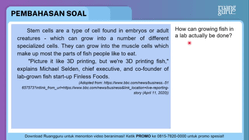Iklan
Pertanyaan
Read the following texts. Answer the questions that follow. CouldSynthetic Fish be a Better Catch of the Day? Overfishing has depleted numbers of wild fish, and fish farms meet much of the growing demand. Could we one day be eating "fish" grown from cells in a factory, as a number of start-ups are planning? Business is booming says David Shenson, the President of Sterling Caviar, which owns four fish farms in Sacramento, California, raising sturgeon for their eggs, better known as caviar. He's not just being self-promotional: The global caviar market reached £670m ($854m) in 2018 and is expected to expand by close to 10% by 2025, according to market research firm Androit Market. Sturgeon is one of the fish that has come under pressure in the wild,the number of wild sturgeon in major river basins has declined by 70% over the last century, according to figures from the World Wildlife Fund. Overfishing and global warming have long wreaked havoc on fish stocks, and a third of marine fish stocks are still being fished at biologically unsustainable levels, according to the UN. Fish farms, like Sterling Caviar, are helping take the pressure off wild stocks, but a handful of start-up firms think they might have another answer. They are experimenting with growing fish "meat" in the lab. Mainly based in Silicon Valley with a couple in Europe and Asia, they have developed techniques to extract fish stem cells and grow them into commercial quantities of edible flesh. Stem cells are a type of cellfound in embryos or adult creatures - which can grow into a number of different specialized cells. They can grow into the muscle cells which make up most the parts of fish people like to eat. "Picture it like 3D printing, but we're 3D printing fish," explains Michael Selden, chief executive, and co-founder of lab-grown fish start-up Finless Foods. (Adopted from: https://www.bbc.com/news/business.-51 657573?intlink_from_url=https://www.bbc.com/news/business&link_location=live-reporting-story (April 11, 2020)) How can growing fish in a lab actually be done?
Read the following texts.
Answer the questions that follow.
Could Synthetic Fish be a Better Catch of the Day?
Overfishing has depleted numbers of wild fish, and fish farms meet much of the growing demand. Could we one day be eating "fish" grown from cells in a factory, as a number of start-ups are planning? Business is booming says David Shenson, the President of Sterling Caviar, which owns four fish farms in Sacramento, California, raising sturgeon for their eggs, better known as caviar.
He's not just being self-promotional: The global caviar market reached £670m ($854m) in 2018 and is expected to expand by close to 10% by 2025, according to market research firm Androit Market. Sturgeon is one of the fish that has come under pressure in the wild, the number of wild sturgeon in major river basins has declined by 70% over the last century, according to figures from the World Wildlife Fund. Overfishing and global warming have long wreaked havoc on fish stocks, and a third of marine fish stocks are still being fished at biologically unsustainable levels, according to the UN.
Fish farms, like Sterling Caviar, are helping take the pressure off wild stocks, but a handful of start-up firms think they might have another answer.
They are experimenting with growing fish "meat" in the lab.
Mainly based in Silicon Valley with a couple in Europe and Asia, they have developed techniques to extract fish stem cells and grow them into commercial quantities of edible flesh.
Stem cells are a type of cell found in embryos or adult creatures - which can grow into a number of different specialized cells. They can grow into the muscle cells which make up most the parts of fish people like to eat.
"Picture it like 3D printing, but we're 3D printing fish," explains Michael Selden, chief executive, and co-founder of lab-grown fish start-up Finless Foods.
(Adopted from: https://www.bbc.com/news/business.-51 657573?intlink_from_url=https://www.bbc.com/news/business&link_location=live-reporting-story (April 11, 2020))
How can growing fish in a lab actually be done?
Iklan
D. Enty
Master Teacher
2
5.0 (3 rating)
Iklan
Pertanyaan serupa
Tanya ke AiRIS
Yuk, cobain chat dan belajar bareng AiRIS, teman pintarmu!
RUANGGURU HQ
Jl. Dr. Saharjo No.161, Manggarai Selatan, Tebet, Kota Jakarta Selatan, Daerah Khusus Ibukota Jakarta 12860
Produk Ruangguru
Bantuan & Panduan
Hubungi Kami
©2025 Ruangguru. All Rights Reserved PT. Ruang Raya Indonesia



















